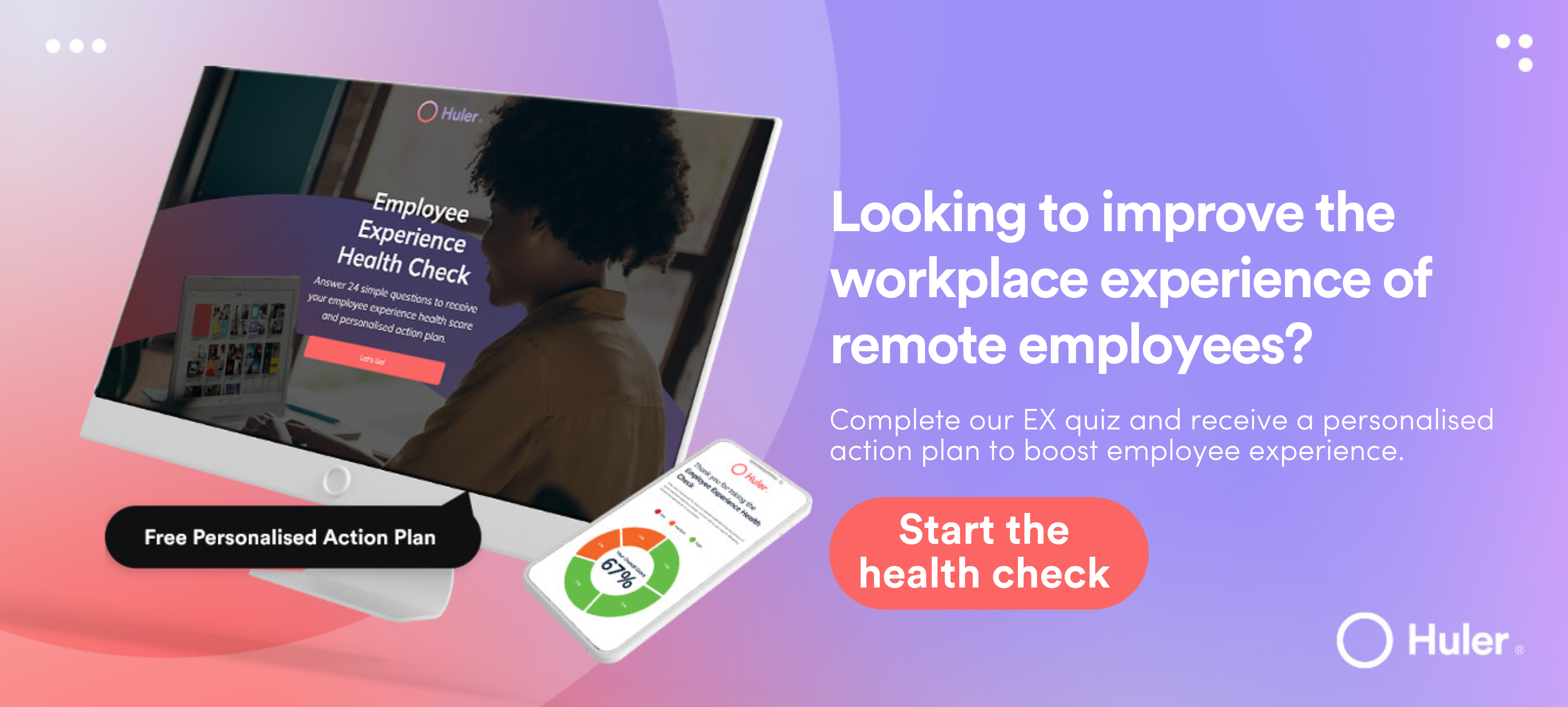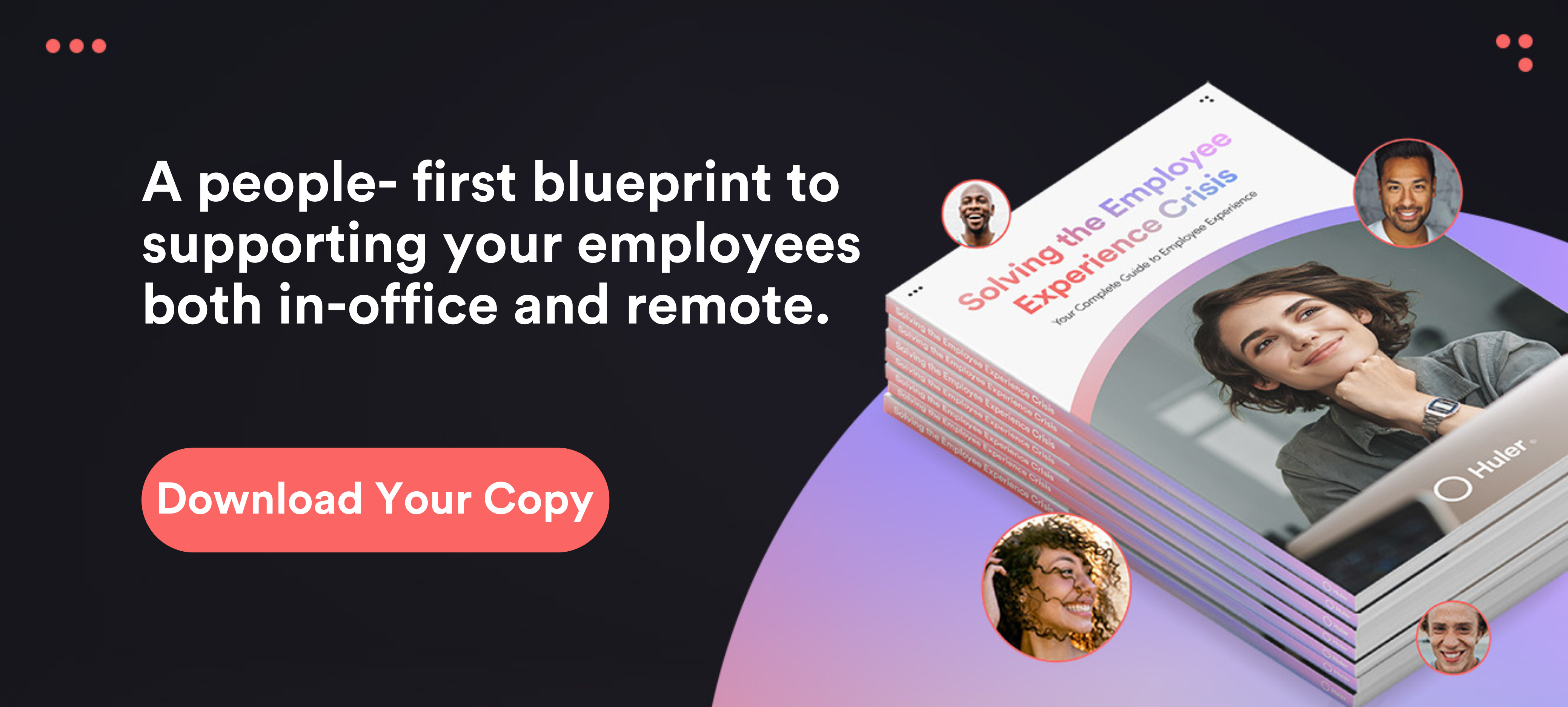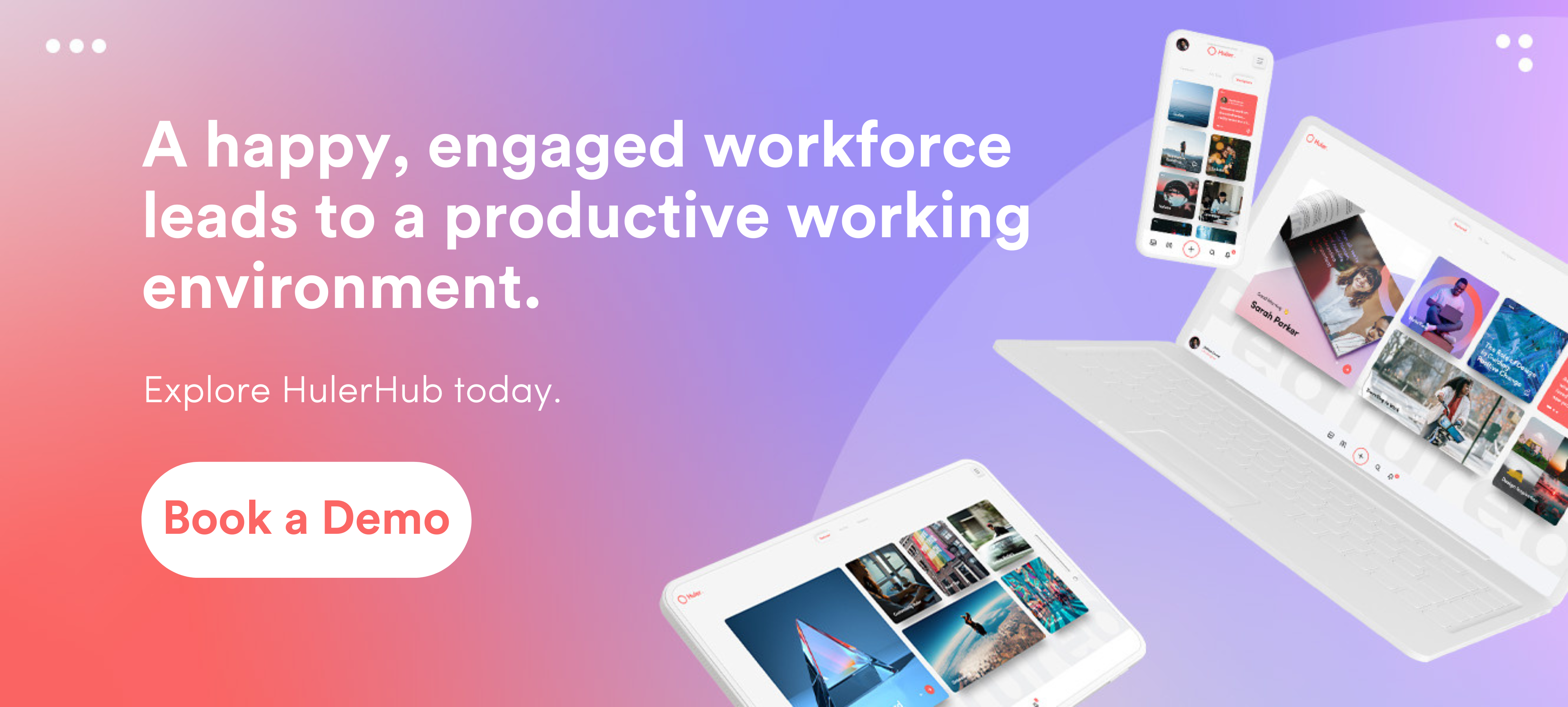Amazingly, digital employee experience platforms are a relatively new concept. While employee engagement platforms have been popular for quite a few years now, the notion of an employee experience platform was really first explored in 2019 by Josh Bersin.
But what exactly is an employee experience platform? And how is it different from the employee engagement platforms we have come to know and love?
Well, wonder no more, because the experts at Huler are on the case. We’ve done the work so you don’t have to, pulling together the ultimate guide on employee experience platforms including:
- Employee Experience Platform Definition
- Common Employee Experience Platform Features
- Why Do You Need An Employee Experience Platform?
- Employee Experience vs Employee Engagement Platforms
- Frequently Asked Questions
- Employee Experience & The Future Of Work
Employee experience is the experience an employee has while working at (or with) your organisation. It is an unavoidable thing, as any interaction we have is classed as an experience. In everything we do, we take something away from that experience which informs our future behaviour and responses.
The employee experience is what your employees take away from interactions with your business. It is not one single experience, but many over a period of time – some positive, others negative. In recent times, HR departments and leaders have realised that when employees feel overwhelmed, left out, unrecognised or burnt out, their performance suffers. So, it’s important for them to do something to alleviate these issues by creating more seamless, frictionless and enjoyable employee experiences.
What Is An Employee Experience Platform?
An employee experience platform is software that gives organisations better control over how employees perceive, experience and interact with work technology and touchpoints in the employee journey, with no need to replace or change their current set up.
The aim of an employee experience platform is to make it easier, quicker and more intuitive for employees to work, communicate, collaborate and connect. It does not target one specific task or area. Instead, it is an extra, personalisable layer that sits on top of existing systems and content making them:
- Easier to find, access, and navigate between
- Secure
- Accessible from anywhere
- Available on any device
And, above all else, creating an experience that is consistent, unified, intuitive, and logical.
Employee experience platforms feed into a number of HR and digital transformation goals. In a world of work where employees are demanding more flexibility and control, the employee experience platform enables hybrid working models while keeping your people in touch and in the loop.
It also offers a much-needed solution to the glut of disparate technology that has started to overwhelm employees over the last few years, providing better security and control while empowering your people to draw better boundaries between their work and personal life with no dip in productivity.
Employee Experience Platform Features
An employee experience platform gives organisations the opportunity to gain a competitive edge in their sectors by taking a flexible, people-first approach designed to get the best out of their people.
Everything In One Place
Employee experience platforms don’t require you to change the systems and technology you’re already using. Rather, they sit on top of those systems and act as a sort of ‘front door’ to them, making them more accessible and easier to find.
Why is this important? Well, digital adoption has (in the words of Mckinsey) taken a ‘quantum leap’ since 2019. As a result, employees have to use lots of different kinds of work tech every single day. What’s more, different teams might use different platforms or software, which can complicate matters even further.
We all know that working in silos is unproductive, and reaching the same levels of collaboration can be difficult in hybrid and remote working set ups. To combat this, employee experience platforms, at their core, bring all of these tools and systems together in one place, making them accessible and easy to find for everyone who needs to use them either on a daily basis or occasionally.
Personalisation
We’ve said it before and we’ll say it again: one size fits all never works. And when things don’t fit well, you’re less likely to use or engage with them. Employee experience platforms offer personalisation for users to boost engagement with all the tools, system and content that lies within them.
What this personalisation looks like can vary from platform to platform. HulerHub, for example, gives individual users the flexibility to create their very own virtual workspaces filled with quick links out to their most used software and content, as well as admin defined workspaces that make use of powerful audience management features to ensure teams see the things that are most relevant to them.
Internal Communications
We all know how important regular internal communications are for a happy workforce. Employee engagement platforms make this quick and easy thanks to baked-in internal communications features. By and large, these platforms provide a dashboard to showcase internal communications, giving employees a front page of news they can access at any time, on any device, wherever they are.
What’s more, tools like HulerHub have audience management features that help HR teams and managers go one step further in personalising internal comms. This means that admins can push out internal communications at the right time to only those who need to see it. This ensures that top down communications remain hyper relevant and engaging, without employees becoming blind to it or overwhelmed because they see so much irrelevant content on a daily basis.
Analytics
Having access to engagement data can do wonders for helping you shape the employee experience. That’s why employee experience platforms often feature some sort of employee engagement analytics for admins.
Analytics dashboards give you an inside look into the times employees are most productive, which content and systems they are engaging with most often, which content and systems they aren’t engaging with at all, and what kinds of activities they are doing throughout the day. Having access to this data empowers admin to both be reactive if they see a dip in engagement across certain teams and proactive in spotting key touchpoints of the employee experience they can work on improving.
Vendor Agnostic Integrations
Your people know what they like and they don’t love being told to use something new or different when they’ve found something that works. The problem is a lot of digital workplaces or intranets are only compatible with their own built in apps or a specific vendor.
Employee experience platforms aim to go against the grain. Rather than dictating what software you can or can’t use with it, it is vendor agnostic, which means you can pull pretty much anything into it and find it when you need it without having to totally migrate or change up your current setup.
This is a really powerful feature, especially for organisations looking to breathe new life into their intranets. With a platform like HulerHub, there’s no need to migrate all of your existing content and comms into a different platform. Instead, everything can be dropped in and taken away quickly at your convenience, helping your business achieve agility as and when it’s needed.
Why Use An Employee Experience Platform?
A lot of people will ask: what’s the point in an employee experience platform when we’ve already got all the systems, tools and content in place?
Our answer: your people are overwhelmed by everything at work. So much so that it’s slowing them down and stressing them out.
It’s all good and well having all the gear, but if your people have no idea how to use it to work smarter, then it’s only going to harm them in the long run.
Work Smarter
An employee experience platform helps your employees work smarter. It gives them a single ‘source of truth’ that they can use anywhere, on any device, to find and engage with the systems and content they need – even if it’s not something they use everyday.
That in itself is a powerful notion. Think about it! How much time could your organisation save when employees no longer have to search and search for what they need? Or worse still spend time speaking to other people in an effort to find something that’s hidden under layers and layers of other virtual stuff.
Communicate Better
Employee experience platforms can also make communicating with your workforce easier too. Getting internal comms right has been infamously hard for a long time, way before the advent of remote work and distributed teams. But now it’s even harder with staff working miles away from your HQ or asynchronously. Platforms like HulerHub make internal comms more engaging, relevant and visible so employees can stay in the loop wherever they are, whenever they work.
Retain your Talent
Now, we’re not suggesting that just having an employee experience platform in place will boost talent retention. However, it certainly can be used to do so. While people leave a workplace for a number of reasons, the majority do so because they are unhappy with some aspect of their work be it inflexibility, the wages, the working environment, their workload or their colleagues.
Employee experience platforms give you the power to take control of the employee experience, especially those moments of truth which may prove to be make or break in the retention stakes. Whether it’s empowering your employees with more flexibility and autonomy or highlighting key content to support the mental health and wellbeing of your people, this kind of software gives you the unique insight and control you need to provide a better people-first experience.
Boost Productivity
As employee experience platforms streamline the ways in which your people work, you can bet they will help boost their productivity too. This is partly down to the fact that they will be able to access what they need quicker and more intuitively, but there are other factors at play too.
For example, employee experience platforms can provide a consistent, logical and unified experience wherever a person works from. This means the organisations can better activate their hybrid working policies with the support of these platforms. And, when employees feel empowered to work flexibility in ways that suit them, they are likely to feel more invested, engaged and motivated.
The result? Better productivity, higher levels of innovation, more transparent communication and happier people. Winner!
Encourage Employee Self Service
Employee self service is technology that empowers employees to handle certain administrative, HR or IT needs on their own. These systems go a long way in saving time for employees, who might have to wait long periods of time for certain jobs to be done, while taking pressure off busy IT and HR teams who are stretched to their limits.
That being said, when employees have gotten so used to doing things a certain way over a period of time, it can be difficult to change their ways. Particularly if a process seems too difficult or long-winded.
Employee experience platforms can combat this by making finding those self service processes and technologies much easier, and putting content relating to them within easy reach. They’re also mobile friendly, which makes accessing self service processes quicker and easier, such as booking annual leave, filling out employee feedback surveys or raising a ticket with IT.
Employee Experience Platforms vs Employee Engagement Platforms: What’s The Difference?
Good question! You’d be forgiven for thinking that these two pieces of software are one and the same. But they’re often not.
Employee engagement platforms are often designed to measure engagement rather than facilitate it. They might focus on core metrics (such as turnover, absences, sentiment, etc) to help you to boost employee engagement outside of the platform itself, however they don’t always give you the tools to do more within it to shape a better employee experience.
Meanwhile, employee experience platforms are designed to provide what is a ‘digital shop front’ of sorts for employees that influences their experience. For example, certain features can be put to good use during onboarding by making everything easy to access and find for new hires. All of this while providing clear actionable insights in the back end for admins to understand how employees engage with content.
Employee experience platforms can also be put to good use in driving intranet adoption, for example, or encouraging use of new technologies your company has invested in. Behind the scenes analytics can then be used to see which tools and tech employees are engaging with and which they aren’t to better measure return on investment and plan for the future.
Many employee engagement tools do not have the capacity to do this and aren’t concerned about bringing everything into one place, rather they are more focused on measuring and tracking feedback and employee sentiment.
Frequently Asked Questions
Is an employee experience platform the same as an intranet?
By and large, no. Employee experience platforms can actually work with your existing intranet, driving adoption and making use of your current investment. The key to employee experience platforms is that they aren’t a replacement for any of the technology you currently have. Rather, they act as a front door to everything, making it more accessible, intuitive and easy to find.
In HulerHub, for example, admins can take links to content within their secure employee intranet and turn them into engaging ‘tiles’ which sit in either the Featured Dashboard or Workspace. These tiles can then be assigned to the most relevant audiences, making them easily accessible. This is especially great for content that is hidden deep within intranets, as it can make visible information and processes that are very rarely interacted with.
Why should we add another platform when we’ve already got loads of tech in play?
Good question, especially when budgets are so tight. Our answer to this would be: have you looked at rates of engagement for the tech you have already? How is it performing?
We’re willing to bet that some of those tech platforms you’ve invested good money into aren’t getting the use they deserve. Or that some of your well honed processes are being bypassed in favour of emails (which get forgotten about), endless meetings (which waste valuable time), or instant messages (which are disruptive).
An employee experience platform isn’t just another piece of work tech for your employees to try once and forget. It’s the front door to absolutely everything you can think of in your digital workplace. It pulls everything together and allows you to see, behind the scenes, what’s worth doing, what isn’t and the areas where your employees might need more support.
Are employee experience platforms hard to set up?
Nope! Not even a little bit! Employee experience platforms are designed to be intuitive and easy to set up. In HulerHub, for example, all admins have to do is upload a CSV file of users (we provide you with a template to get started), create your audiences and away you go! From then on you have everything you need to start creating employee experiences that leave a lasting impression on your people for the better.
Are employee experience platforms only worth it for big companies?
Employee experience platforms can be a huge asset for large companies with lots of employees. Especially those with hybrid or distributed workforces. However, the same also applies for smaller companies.
Regardless of the scale of your business, you’re probably already using a glut of technology and systems, alongside reams and reams of digitised content. This is pretty much a universal problem with every business. Employee experience platforms help make sense of all this for both HR departments, managers, employees, CEOs and everyone in between. What’s more, they’re so intuitive and easy to use that you don’t need a legion of IT boffins to get started or to maintain it.
On top of all this, many employee experience platforms are scalable. This means that you only pay for how many users you need, rather than for a whole system full of bells and whistles that will probably never get used. This coupled with the flexibility of the platform itself means you can shape your employee experience tool into something that works for your business no matter the size now and in the future.
Employee Experience & The Future Of Work
The employee experience has always been important, but employers are only just awakening to its potential now. No matter how much work tech, automation and machine learning you have in play, it will always be the humans combined with this technology that gives your business the edge.
Focusing on enhancing the employee experience helps businesses capitalise on their biggest assets in a way that is fair, inclusive and beneficial for everyone. This is particularly true in a world where we are becoming increasingly focused on technology and the ways in which it can save time or streamline our working processes.
HulerHub is an employee experience platform that brings all of your content, systems and comms together in one secure place. It offers personalisation features on both an individual and admin level, giving you more control of the employee journey. Best of all, it is totally vendor agnostic. No matter what technology you use, from Google Workplace to Microsoft Teams, Slack, Salesforce and beyond, HulerHub makes space for it and puts it within easy reach for all those who need it.
To find out more, book a demo to see HulerHub in action and discover what it can do for your employee experience.








